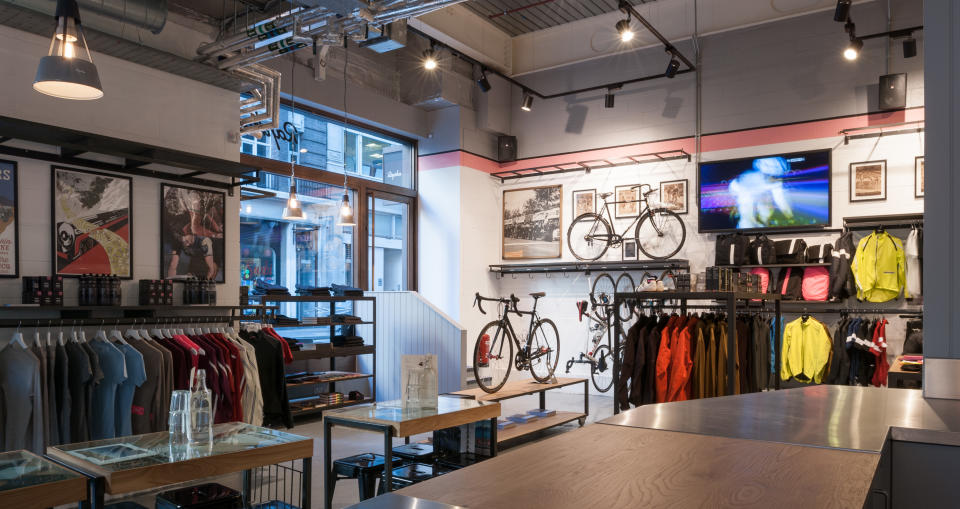How to successfully run brick-and-mortar retail in the Amazon era
Rapha is one of the most recognizable companies in cycling, having single-handedly changed the apparel trends from flashy, logo-heavy clothing to something simpler and refined. Since 2004, the company and its founder Simon Mottram understood the idea of “athleisure”—athletic clothes that pass the fashion test—long before it became the next big thing.
Unlike most retailers, however, Rapha, which is based in London and Portland, Ore., and sells cycling apparel, has gone against the current and expanded its brick-and-mortar business. (Rapha does the vast majority of its business directly from its website; it doesn’t wholesale to other retailers.) It’s a gamble that thins out margins, but for a developing sport—and an intimidating one for many—the potential for payoff is big. The strategy? Make it more than just a store.
“We made a very definite choice to not call them stores, to call them clubhouses,” Rapha chief marketing officer Sarah Clarke told Yahoo Finance. “The reason we did it is to really build communities.”
The decline of brick and mortar
Brick-and-mortar stores have had a tough time in the past few years, and things are getting worse. At the end of April, a report from Credit Suisse noted that store closings in 2017 had already surpassed numbers from 2008. So far, 2,880 store closings have been announced in 2017, significantly outpacing 1,153 the year before.
It’s no secret who the culprits are. Amazon (AMZN) is chief among them: an estimated 80 million people in the US are Amazon Prime members, according to Consumer Intelligence Research Partners. That covers quite a lot of households, and more of them appear to prefer shopping in the living room, in a waiting room, or wherever they happen to be on their phones. Combined with ever-shortening delivery times for Amazon and other e-commerce companies, it is a challenge to compete.
All this has led to a big, multibillion-dollar question: What exactly is the place of brick-and-mortar stores in the Amazon era? Rapha is providing one possible, albeit niche, avenue.
Stores may not survive, but clubhouses might
The Rapha model for a retail store is almost one of a religious mission, aiming to conquer and convert, and then provide apparel and gear to the fresh disciples in the community.
Rapha’s cycle clubs – which often start out as pop-ups in hip active areas like Chicago and Seattle before becoming full-fledged physical stores – feature coffee, art shows, guest speakers, group rides, and more. Though they do sell gear, it almost seems an afterthought to a celebration of cycling.
Already in 16 cities, Rapha is reinvesting to grow this physical space. “We’ve got massive aspirations,” said Clarke. “We’d love to get to 50 cities around the world in the next few years.”

Despite only having limited equity funding of around $7.3 million, Rapha’s 2016 sales topped $80 million—with 30% growth over the year before—giving it money for expansion. (Rapha is currently private, though unconfirmed rumors of a sale to LMVH have brewed for a while.)
The clubs also have put a strong focus on women’s rides and apparel in an effort to make cycling a more welcoming place for women. (The sport’s gender issues are bountiful: unequal prize money for women, “podium hosts,” and no women’s Tour de France.) If the cycling clubs are missions, it makes sense to go after all potential converts.
A better marketing tool than pro athletes?
For Rapha, putting chips on physical spaces and fostering a community has been done by taking chips off something else: pro sponsorship at cycling’s highest level. From 2013 to 2016, Rapha sponsored Team Sky with enough success for them to be considered the New York Yankees of cycling, winning three out of four Tours de France during those four years. At the pinnacle of their success, however, they departed from the World Tour.
“We’ve moved away from Team Sky so we can look at the grassroots of team involvement, and that for us is our cycling club,” said Clarke.

In the last bike boom, driven by Lance Armstrong’s success, pro gear was what new fans and converts wore, despite their bold look being dictated by whatever sponsor happened to support the team (in Armstrong’s case, it was the USPS and Discovery Channel).
But the utility of the professionals as a marketing tool is complicated with today’s trends toward minimalism. Plenty of people choose to sweat in Lululemon (LULU), Outdoor Voices, and other less-overtly sporty apparel that is decidedly anti-pro and anti-logo. Or for cycling, to use many of Rapha’s popular jerseys that are wool and minimally branded—two things that would never fly in a professional league that only survives thanks to benefactors who pay for large brand placement.
Though perhaps less useful from a marketing standpoint these days, professionals still offer valuable feedback in a technical, R&D sense. “What it brings directly to us as a brand is it gives us the insights,” said Clarke. So while Rapha is out at the highest levels of the sport—think the Tour de France—the company is still involved at the women’s and development team levels, with Canyon-SRAM and Team Wiggins, respectively. It’s a move that keeps the R&D pipeline going, while also putting money towards growing the sport and its potential market.
Moving the focus from the Yankees of pro cycling to women’s pro cycling, up-and-coming pros, and regular bike-riders isn’t really the traditional playbook for a cycling company. But since cycling isn’t just a sport that people watch—they do it themselves, often on the same roads—it just might be a shrewd strategy.
Ethan Wolff-Mann is a writer at Yahoo Finance focusing on consumer issues, tech, and personal finance. Follow him on Twitter @ewolffmann. Got a tip? Send it to tips@yahoo-inc.com.
Read more:
How CEOs reacted to Trump’s withdrawal from the Paris agreement
Study shows how GOP plan would lower premiums: ditching costly, sick people
How the Obamacare repeal could affect your employer insurance
The biggest problem with robots taking jobs may not be unemployment—yet
What Facebook and Twitter think they know about you
Online savings accounts are raising rates. Big banks aren’t.

